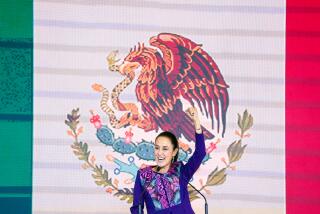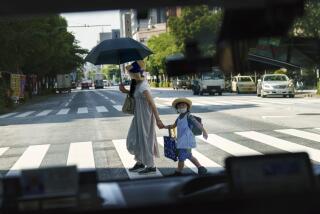In demographically impaired Japan, women still face gender bias
Prime Minister Shinzo Abe has a bit of tough-guy swagger: He hasn’t been afraid to ruffle China’s feathers by visiting a controversial war shrine and he’s pushed to revise Japan’s pacifist constitution. Yet he’s also become one of Asia’s most vocal advocates for women.
He has four female ministers in his Cabinet, including the justice minister and one who’s been given the newly created job of “promoting women’s active participation.” Abe, who also selected a woman to lead his party’s policy research council, has said that Japan should aim to have women occupy 30% of leadership roles in both government and the private sector by 2020.
Abe isn’t the first Japanese politician to see women as economic lifeblood, but he has been more vocal and aggressive than his predecessors in pushing for change, experts say. He says he sees women as the best untapped resource to bolster Japan’s economy — the world’s third-largest behind the U.S. and China — as the nation’s population ages and its fertility rate declines.
According to the government, 26% of Japan’s 127 million people are 65 or older. The country’s fertility rate of just 1.43 births per woman has long had economists fretting that the country is heading into an Armageddon of sorts as the workforce eligible to sustain Japan’s economy declines.
The economic situation is worrisome: Japan’s GDP growth has been generally sluggish for most of the last 25 years. Japan’s seasonally adjusted gross domestic product fell an annualized 7.1% from April to June this year compared with the previous quarter. Analysts say the main culprit was a consumption tax increase that kicked in April 1, reining in businesses and consumers, but the overall demographic trends remain worrisome.
In 1986, Japan passed an equal employment opportunity act and since then the law has been revised to ban discrimination based on gender. But statistics indicate the country has a long way to go to level the playing field.
Women in Japan are still largely expected to be stay-at-home wives and mothers once they marry, and climbing the corporate ladder remains difficult. Japan’s working-age population is divided evenly between men and women, but nearly 38 million men are in the workforce, compared with fewer than 28 million women, government data from 2012 show.
Abe’s goals of increasing the number of women in leadership roles and in the workplace in general will be tough to reach, experts say.
Yutaka Harada, political science professor at Waseda University in Tokyo, said a shortage of child-care centers and workers precludes many Japanese women from taking jobs. That despite the fact that child care in Japan is often publicly funded and therefore not as expensive as in the United States. Tight immigration policies also mean there is a smaller employment pool for child-care positions than in many Western countries. There is also little tradition in Japan of hiring outsiders to work as nannies.
Much of the problem stems from deeply ingrained cultural attitudes, said Mariko Kawaguchi, chief researcher at the Daiwa Institute of Research.
Japanese men, for example, are regarded as “assistants” and not equal partners when it comes to child rearing or housework, she said, citing government research showing women typically contribute four hours of housework a day while men pitch in 46 minutes.
“The gender role gap is large,” Kawaguchi said, and reforms have been “too little too late.”
Companies including auto giant Nissan Motor have begun implementing work-from-home policies for many employees. But Chie Kobayashi, general manager of the auto giant’s diversity development office, said time management remains her greatest challenge.
The mother of two said she still typically works in the office from 8:30 a.m. until about 7 p.m. — then takes additional work home.
She said many colleagues, especially those in research and development and sales and marketing, stay until 10 p.m.
“Managers’ workloads are out of control,” Kobayashi said.
In government, Abe has gone out of his way to emphasize the contributions of women in his administration.
“All of those female Cabinet members and ruling party board members are people of excellence brimming with ability and drive,” Abe, 60, said recently. (In October, he had to accept the resignation of two female ministers amid questions about their campaign finances, but he replaced one of the two with another woman.)
Abe jokingly calls his wife, Akie, “the domestic opposition” but says that “with regard to the dynamic engagement of women, there are no differences whatsoever between us.” The couple have no children.
Haruko Arimura, 44, who recently took the women’s-participation ministerial position, noted at a news conference in September that she is a mother with children still at home. At least two of Abe’s other female ministers are mothers as well.
She is in the somewhat tricky position of being in charge of encouraging women to have more children while ushering more of them into the workforce.
In June, a Tokyo city assemblyman, Akihiro Suzuki, heckled a colleague, Ayaka Shiomura, while she was speaking at an assembly session that dealt with the topic of women delaying marriage. Among his comments: “You should get married yourself!”
A week later, Suzuki made a public apology, bowing to Shiomura.
“The most difficult part may be transforming the division of roles based on gender, something that is, unwittingly, firmly ingrained within us,” Abe said during a speech at a women’s leadership event in September. “It is deeply regrettable that we still encounter remarks that should be called sexual harassment.”
Nagano is a special correspondent.
More to Read
Sign up for Essential California
The most important California stories and recommendations in your inbox every morning.
You may occasionally receive promotional content from the Los Angeles Times.





